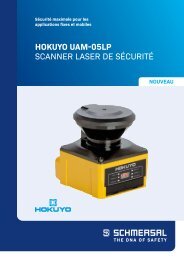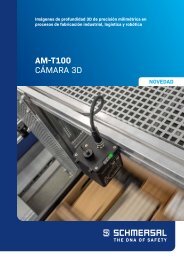mrl news | Edition 2020.2 [EN]
Functional machine safety is a complex issue: The mrl news provides information and news on all aspects of this topic, such as innovations in safety systems and safety switching devices, changes in standards and guidelines, comments and tips for practical implementation and much more. You can download or print easily and conveniently the required issue.
Functional machine safety is a complex issue: The mrl news provides information and news on all aspects of this topic, such as innovations in safety systems and safety switching devices, changes in standards and guidelines, comments and tips for practical implementation and much more.
You can download or print easily and conveniently the required issue.
Create successful ePaper yourself
Turn your PDF publications into a flip-book with our unique Google optimized e-Paper software.
<strong>mrl</strong><strong>news</strong><br />
The essential characteristic of an incomplete machine<br />
is that it is unable to fulfil a specific function. ‘Interlinked<br />
machines’ or ‘machine plants’ satisfy the criteria for<br />
‘assemblies of machinery’ if they form a productionrelated<br />
link and a safety-related link, through either<br />
a) the (spatial) arrangement<br />
b) the common production objective (joint manufacture of<br />
a specific product) or<br />
c) a joint, higher-level functional control system. In this<br />
sense, a simple emergency-stop link is not considered<br />
a safety-related link or ‘assembly of machinery.’<br />
Start at the beginning – the right time for a risk<br />
assessment<br />
A risk assessment should not be carried out only once a<br />
new machine has been fully assembled. To begin with,<br />
the Machinery Directive stipulates that a machine must be<br />
‘designed and constructed taking into account the results<br />
of the risk assessment.’<br />
Secondly, the obligatory three-stage process for risk<br />
reduction (see 5) requires ‘inherently safe design’ as<br />
the primary solution model. This can, however, only be<br />
achieved in the planning phase. Thirdly, once the machine<br />
has been constructed, it is often no longer possible to<br />
identify design errors (e.g. incorrectly selected parts).<br />
Fourthly, dangers that are only identified at the end of<br />
the design process can usually only be eliminated or<br />
minimised with increased technical and financial outlay.<br />
It is, therefore, worthwhile to consult machinery safety<br />
specialists during the planning stage for a new machine<br />
or plant – e.g. an external service provider. They offer a<br />
neutral and unbiased view and can provide tips on how<br />
safety solutions can best be designed to be as cost<br />
efficient as possible and ensure that they do not restrict<br />
plant availability and productivity during later operation.<br />
Figure: German Federal Institute for Occupational Safety<br />
and Health (BAuA)<br />
Furthermore, the risk assessment is not a one-off process<br />
that simply needs to be ticked off on a list, but rather an<br />
‘iterative’ process to support the design, i.e. it is a process<br />
that needs to be repeated several times and until the risks<br />
have been sufficiently eliminated or minimised. Any retrofit<br />
or conversion of a machine may, however, result in certain<br />
safety functions or parts of the safety concept needing to<br />
be revised, in which case the risk assessment will need to<br />
be adapted or supplemented.<br />
You can download the complete tec.nicum white paper at:<br />
<strong>Edition</strong> 2020.02<br />
Page 11


![mrl news | Edition 2020.2 [EN]](https://img.yumpu.com/64743824/11/500x640/mrl-news-edition-20202-en.jpg)



![mrl news | Edition 2023.02 [EN]](https://img.yumpu.com/68523556/1/184x260/mrl-news-edition-202302-en.jpg?quality=85)
![mrl news | Edition 2023.02 [DE]](https://img.yumpu.com/68523540/1/184x260/mrl-news-edition-202302-de.jpg?quality=85)
![tec.nicum - excellence in safety [IT]](https://img.yumpu.com/68507978/1/184x260/tecnicum-excellence-in-safety-it.jpg?quality=85)
![Caja de distribución segura SFB PN / EIP / EC [ES]](https://img.yumpu.com/68480263/1/184x260/caja-de-distribucion-segura-sfb-pn-eip-ec-es.jpg?quality=85)
![Safety Fieldbox PN/EIP/EC - Universell. Sicher. Günstig. [DE]](https://img.yumpu.com/68479129/1/184x260/safety-fieldbox-pn-eip-ec-universell-sicher-gunstig-de.jpg?quality=85)
![Machineveiligheid voor de intralogistiek [NL]](https://img.yumpu.com/68456411/1/184x260/machineveiligheid-voor-de-intralogistiek-nl.jpg?quality=85)
![Securité des machines pour l'intralogistique [FR]](https://img.yumpu.com/68456406/1/184x260/securite-des-machines-pour-lintralogistique-fr.jpg?quality=85)
![Maschinensicherheit für die Intralogistik [DE]](https://img.yumpu.com/68456402/1/184x260/maschinensicherheit-fur-die-intralogistik-de.jpg?quality=85)
![Machine Safety for Intralogistics [EN]](https://img.yumpu.com/68456398/1/184x260/machine-safety-for-intralogistics-en.jpg?quality=85)
![AS-interface Safety at Work [EN]](https://img.yumpu.com/68381284/1/184x260/as-interface-safety-at-work-en.jpg?quality=85)

![mrl news | Edition 2019.1 [EN]](https://img.yumpu.com/68012718/1/184x260/mrl-news-edition-20191-en.jpg?quality=85)
![mrl news | Edition 2019.1 [DE]](https://img.yumpu.com/68012709/1/184x260/mrl-news-edition-20191-de.jpg?quality=85)